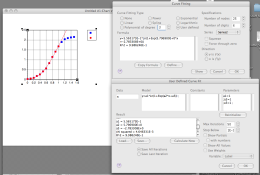Well, we have a disagreement, that appears will never be settled, as to what is relevant. I find the HD curve goes from no exposure through to and past solarization and reversal. Exposure past that which results in DMax is common, as is exposure under the DMin point. The sections of the HD curve that deal with under and over exposure do exist and do have to be dealt with. As an example, we all make flashing exposures below the DMin exposure. ...
Nicholas
Let's just stick to toe, midsection and shoulder, shall we? That's what's relevant!
Oh yes, polynomials can do that, and so can simple nonlinear equations. No need to patch up curve fits.


 Thanks. (I should have figured it out as that y(x) vs y(x) swap is how I am getting the 'inertia'.)
Thanks. (I should have figured it out as that y(x) vs y(x) swap is how I am getting the 'inertia'.)


